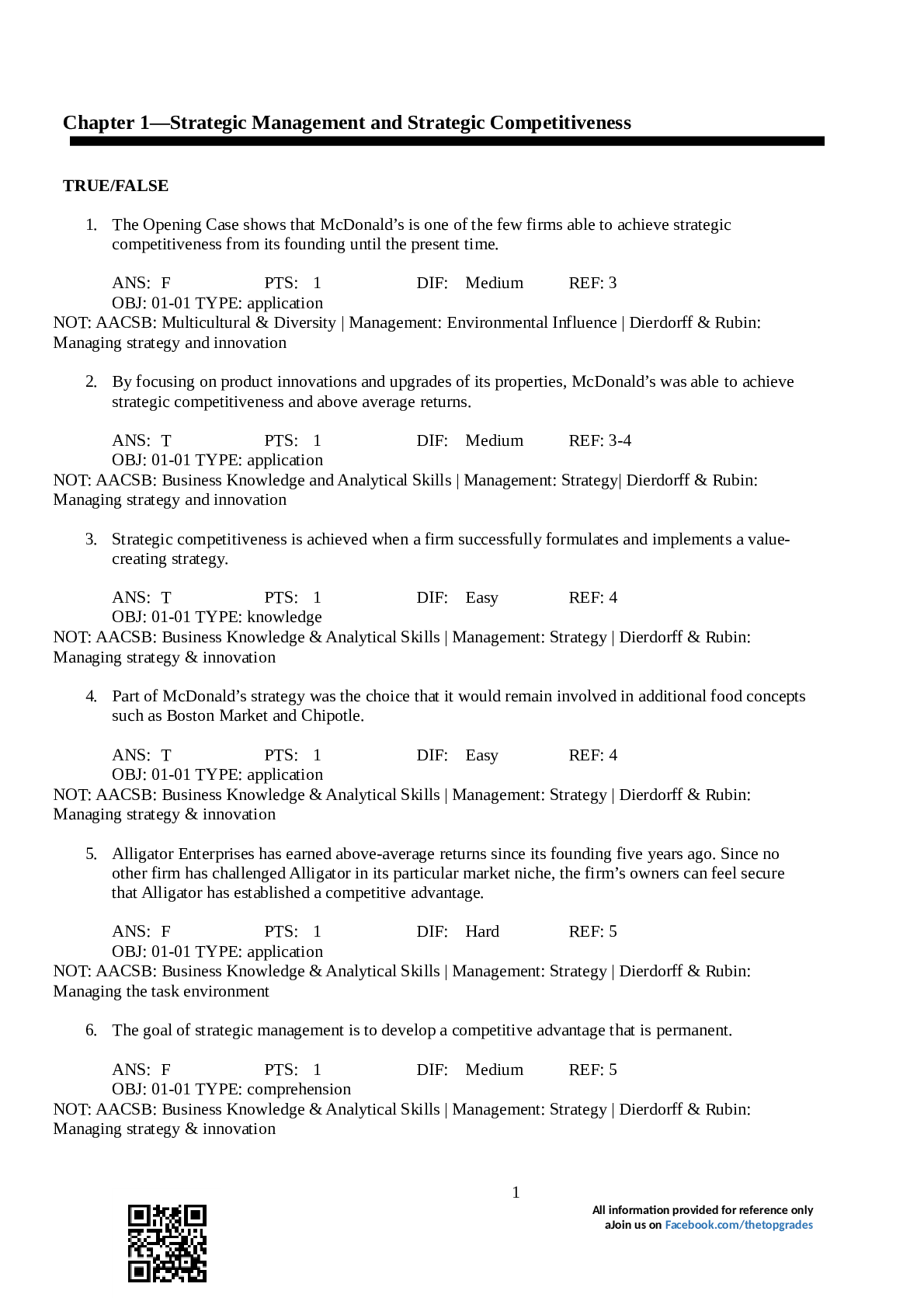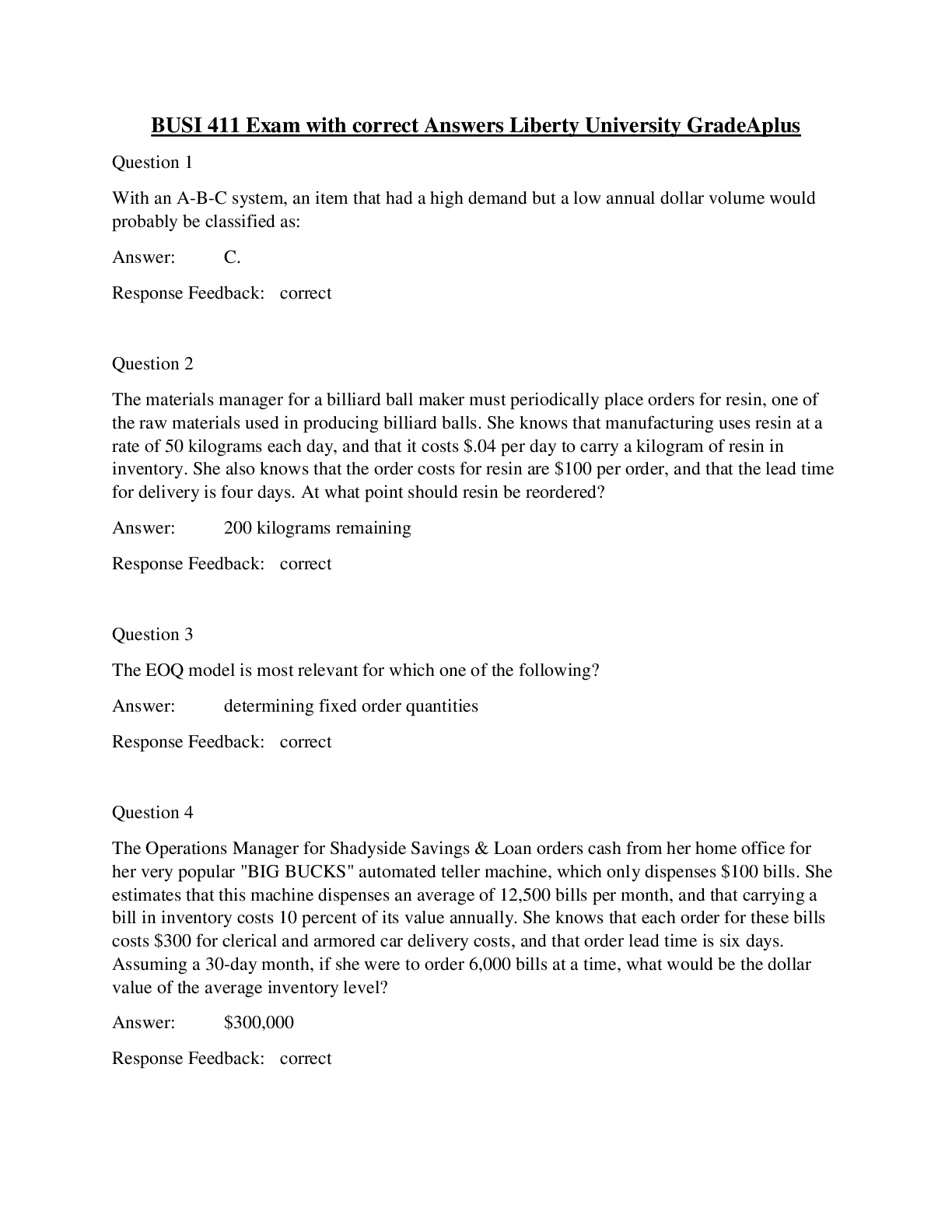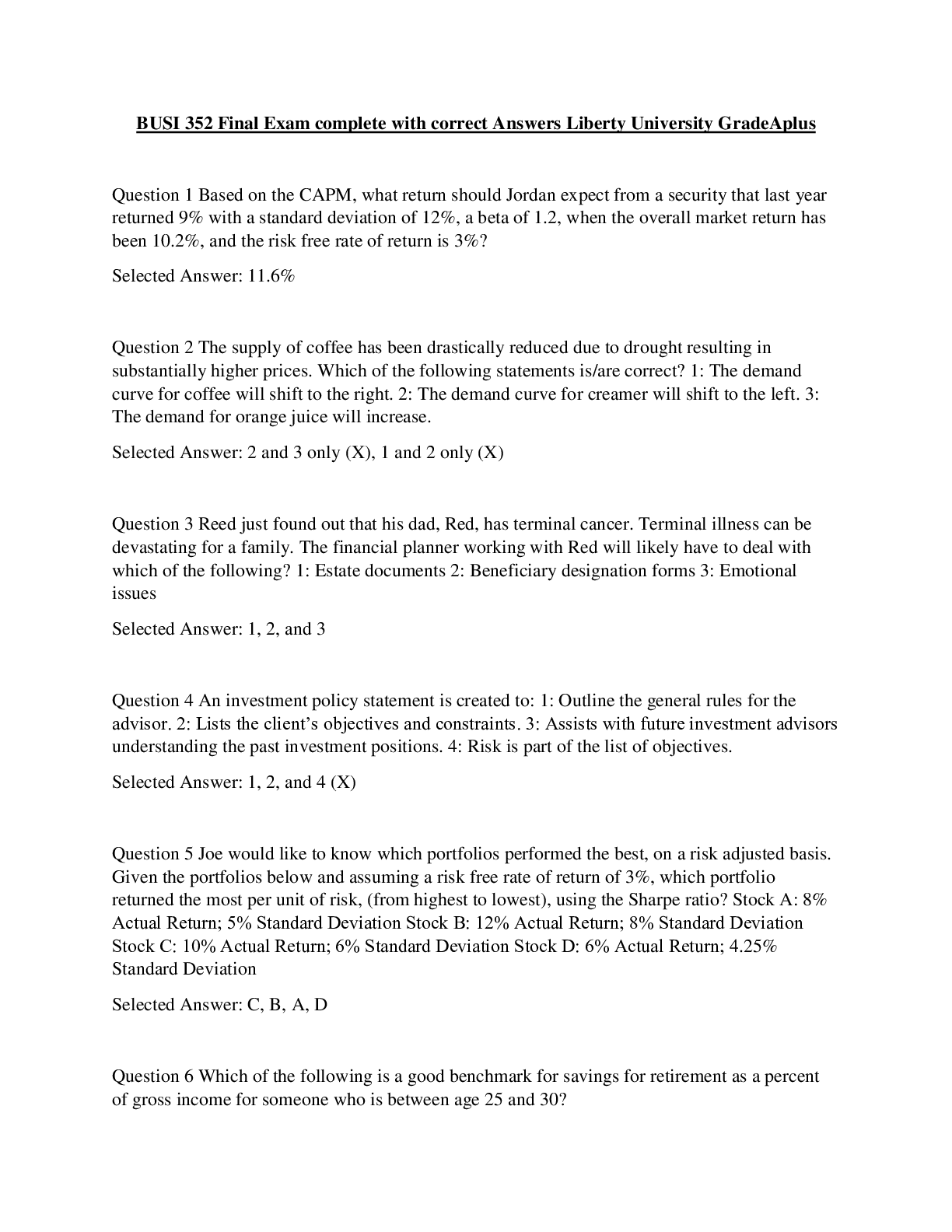*NURSING > EXAM > Drexel NUR 550 Final Exam; Cumulative Review Questions With Correct Answers 2022 (All)
Drexel NUR 550 Final Exam; Cumulative Review Questions With Correct Answers 2022
Document Content and Description Below
Drexel NUR 550 Final Exam; Cumulative Review Questions With Correct Answers 2022 Which of the following is NOT considered a risk factor for the developing of melanoma? a). Light hair and eyes b)... . Female gender c). Severe sunburns in childhood d). 1-4 dysplasyic moles - Correct Answer- b). Female gender When using the otoscope to inspect the inside of the nose, which of the following structures is not visible? a). Inferior turbinate b). Middle turbinate c). Superior turbinate d). All of the above - Correct Answer- c). Superior turbinate When palpating the thyroid, which of the following is true? a). Flex the neck slightly backward b). Place the index fingers just above the cricoid cartilage c). The thyroid isthmus may not be palpable d). A bruit auscultated over the lateral lobe is expected - Correct Answer- b). Place the index fingers just above the cricoid cartilage During the palpation of a patient's thyroid gland you note a multinodular gland. Which of the following is the first on your list of differential diagnoses? a). Thyroid cancer b). Hashimoto's thyroiditis c). Grave's disease d). A metabolic process - Correct Answer- d). A metabolic process You are evaluating a 4 year-old male patient with ear pain. You note the patient has a temperature of 102.4F. While performing your exam, you note the patient is pulling at his left ear. What is our most likely differential diagnosis? a).Otitis externa b). Otitis media c). Tinnitus d). Ottorhea - Correct Answer- b). Otitis media You are using a Snellen chart to evaluate a patient's visual acuity, which of the following is true? Select all that apply: a). Have the patient stand back 20 ft. from the chart b). Have the patient use their hand to cover one eye c). You are evaluating cranial nerve II d). Evaluate visual acuity with both eyes open - Correct Answer- a). Have the patient stand back 20 ft. from the chart & c). You are evaluating cranial nerve II Within 48-72 hours after the birth, a neonate has bilateral copious purulent drainage from the eyes. You most likelu differential diagnosis is? a). Gonococcal conjunctivitis b). Allergic conjunctivitis c). Bacterial conjunctivitis d). Viral conjunctivitis - Correct Answer- a). Gonococcal conjunctivitis Which of the following are normal findings during the ophthalmoscope examination? Select all that apply: a). The physiologic cup is 70% of the optic disc b). the area of the macula is absent of blood vessels c). The optic rim is fuzzy in appearance d). The optic disc should be orange in appearance - Correct Answer- b). the area of the macula is absent of blood vessels & d). The optic disc should be orange in appearance You are beginning the examination of the skin on a 25-year-old teacher. You have previously elicited that she came to the office for evaluation of fatigue, weight gain, and hair loss. You strongly suspect that she has hypothyroidism. What is the expected moisture and texture of the skin of a patient with hypothyroidism? a). Dry and smooth b). Moist and rough c). Moist and smooth d). Dry and rough - Correct Answer- d). Dry and rough A 72-year-old teacher comes to a skilled nursing facility for rehabilitation after being in the hospital for 6 weeks. She was treated for sepsis and respiratory failure and had to be on the ventilator for 3 weeks. You are completing your initial assessment and are evaluating her skin condition. On her sacrum there is full-thickness skin loss that is 5 cm in diameter, with damage to the subcutaneous tissue. The underlying muscle is not affected. You diagnose this as a pressure ulcer. What is the stage of this ulcer? a). Stage 3 b). Stage 1 c). Stage 2 d). Stage 4 - Correct Answer- a). Stage 3 A 68-year-old retired farmer comes to your office for evaluation of a skin lesion. On the right temporal area of the forehead, you see a flattened papule the same color as his skin, covered by a dry scale that is round and feels hard. He has several more of these scattered on the forehead, arms, and legs. Based on this description, what is your most likely diagnosis? a). Actinic keratosis b). Seborrheic keratosis c). Squamous cell carcinoma d). Basel cell carcinoma - Correct Answer- a). Actinic keratosis Mrs. Hill is a 28-year-old African-American with a history of SLE (systemic lupus erythematosus). She has noticed a raised, dark red rash on her legs. When you press on the rash, it doesn't blanch. What would you tell her regarding her rash? a). It is likely to be related to an exposure to a chemical. b). It should not cause any problems c). It is likely to be related to an allergic reaction d). It is likely to be related to her lupus - Correct Answer- d). It is likely to be related to her lupus Jacob, a 33-year-old construction worker, complains of a "lump on his back" over his scapula. It has been there for about a year and is getting larger. He says his wife has been able to squeeze out a cheesy-textured substance on occasion. He worries this may be cancer. When gently pinched from the side, a prominent dimple forms in the middle of the mass. What is most likely? a). A malignant lesion b). An enlarged lymph node c). An actinic keratosis d). A sebaceous cyst - Correct Answer- d). A sebaceous cyst A 38-year-old accountant comes to your clinic for evaluation of a headache. The throbbing sensation is located in the right temporal region and is an 8 on a scale of 1 to 10. It started a few hours ago, and she has noted nausea with sensitivity to light; she has had headaches like this in the past, usually less than one per week, but not as severe. She does not know of any inciting factors. There has been no change in the frequency of her headaches. She usually takes an over-the-counter analgesic and this results in resolution of the headache. Based on this description, what is the most likely diagnosis of the type of headache? a). Cluster b). Tension c). Migraine d). Analgesic rebound - Correct Answer- c). Migraine Which of the following is a "red flag" regarding patients presenting with headache? a). Unilateral headache b). Pain over the sinuses c). Age over 50 d). Photophobia and phonophobia - Correct Answer- c). Age over 50 Very sensitive methods for detecting hearing loss include which of the following? a). The whisper test b). The tuning fork test c). Audiometric testing d). The finger rub test - Correct Answer- c). Audiometric testing A college student presents with a sore throat, fever, and fatigue for several days. You notice exudates on her enlarged tonsils. You do a careful lymphatic examination and notice some scattered small, mobile lymph nodes just behind her sternocleidomastoid muscles bilaterally. What group of nodes is this? a). Occipital b). Tonsillar c). Submandibular d). Posterior cervical - Correct Answer- d). Posterior cervical A 35-year-old archaeologist comes to your office (located in Phoenix, Arizona) for a regular skin check-up. She has just returned from her annual dig site in Greece. She has fair skin and reddish-blonde hair. She has a family history of melanoma. She has many freckles scattered across her skin. From this description, which of the following is not a risk factor for melanoma in this patient? a). Hair color b). Actinic lentigines c). Heavy sun exposure d). Age - Correct Answer- d). Age Is the following statement true or false? When assessing the patient's thought content, it is important to always follow specific questions to keep the patient on task. a). True b). False - Correct Answer- b). False Which of the following is true about hallucinations? a). Experiences may or may not be recognized by the person as false. b). Hallucinations may be auditory, visual, olfactory, gustatory, tactile, or somatic. c). Do not include false perceptions associated with dreaming and falling asleep. d). All of the above. - Correct Answer- d). All of the above. Coordination of muscle movement requires that four areas of the nervous system function in an integrated way. Coordinating eye, head, and body movements applies to which area of the nervous system? a). Motor system b). Cerebellar system c). Vestibular system d). Sensory system - Correct Answer- c). Vestibular system Which of the following statements regarding reinforcement when assessing reflexes is true? a). Used when reflexes are symmetrically hyperactive b). Technique involves isometric contraction of other muscles c). Supports the unsteady patient d). All of the above - Correct Answer- b). Technique involves isometric contraction of other muscles A patient presents to you with shoulder pain after falling during an ice storm. On examination, he exhibits localized shoulder pain when you preform the "crossover test" (arm moved across the chest toward the opposite side while extended at the elbow). Which of the following is the most likely site of injury? a). Rotator cuff b). Bicipital tendon c). Glenohumeral joint d). Acromioclavicular joint - Correct Answer- d). Acromioclavicular joint A patient who presents to the clinic complaining of hand pain says she was told by a friend that it is most likely carpal tunnel syndrome. Upon assessing the patient, you note the following. Which finding would be suggestive of carpal tunnel syndrome? a). Hand pain when holding both hands in acute extension b). Numbness and tingling when tapping over the course of the radial nerve c). Symptoms related to compression are evident in all fingers d). None of the above - Correct Answer- d). None of the above ---- b). MEDIAL NERVE is correct c). FIRST THREE FINGERS is correct You are assessing a patient with joint pain and are trying to decide whether it is inflammatory or noninflammatory in nature. Which one of the following symptoms is consistent with an inflammatory process? a).Tenderness b).Ecchymosis c).Nodules d).Cool temperature - Correct Answer- a).Tenderness An 85-year-old retired housewife comes with her daughter to establish care. Her daughter is concerned because her mother has started to fall more. As part of her physical examination, you ask her to walk across the examination room. Which of the following is not part of the stance phase of gait? a). Heel strike b). Foot arched c). Push-off d). Mid-stance - Correct Answer- b). Foot arched A 32-year-old warehouse worker presents for evaluation of low back pain. He notes a sudden onset of pain after lifting a set of boxes that were heavier than usual. He also states that he has numbness and tingling in the left leg. He wants to know if he needs to be off of work. What test should you perform to assess for a herniated disc? a). Phalen's test b). Straight-leg raise c). Leg-length test d). Tinel's test - Correct Answer- b). Straight-leg raise A high school soccer player "blew out his knee" when the opposing goalie's head and shoulder struck his flexed knee while the goalie was diving for the ball. All of the following structures were involved in some way in his injury, but which of the following is actually an extra-articular structure? a). Synovium b). Juxta-articular bone c). Joint capsule d). Tendons - Correct Answer- d). Tendons A 28-year-old book editor comes to your clinic, complaining of strange episodes. He states that about once a week for the last 3 months his left hand and arm will stiffen and then start jerking. He says that after a few seconds his whole left arm and then his left leg will also start to jerk. He denies any loss of consciousness or loss of bowel or bladder control. When the symptoms resolve, his arm and leg feel tired but otherwise he feels fine. His past medical history is significant for a cyst in his brain that was removed 6 months ago. He is married and has two children. His parents are both healthy. On examination you see a scar over the right side of his head but otherwise his neurologic examination is unremarkable. What type of seizure disorder is he most likely to have? a). Complex partial seizure b). Simple partial seizure (Jacksonian) c). Generalized tonic-clonic seizure d). Generalized absence seizure - Correct Answer- b). Simple partial seizure (Jacksonian) A 21-year-old engineering student comes to your office, complaining of leg and back pain and of tripping when he walks. He states this started 3 months ago with back and buttock pain but has since progressed to feeling weak in his left leg. He denies any bowel or bladder symptoms. He can think of no specific traumatic incidences but he was a defensive lineman in high school and junior college. His past medical history is unremarkable. He denies tobacco use or alcohol or drug abuse. His parents are both healthy. On examination he is tender over the lumbar spine and he has a positive straight-leg raise on the left. His Achilles tendon deep reflex is decreased on the left. While watching his gait you notice he has to pick his left foot up high in order not to trip. What abnormality of gait does he most likely have? a). Sensory ataxia b). Steppage gait c). Parkinsonian gait d). Spastic hemiparesis - Correct Answer- b). Steppage gait Steve has had a stroke and comes to you for follow-up today. On examination you find that he has increased muscle tone, some involuntary movements, an abnormal gait, and a slowness of response in movements. He most likely has involvement of which of the following? a). The corticospinal tract b). The cerebrum c). The basal ganglia d). The cerebellum - Correct Answer- c). The basal ganglia. CONTINUES.... [Show More]
Last updated: 2 years ago
Preview 1 out of 30 pages

Buy this document to get the full access instantly
Instant Download Access after purchase
Buy NowInstant download
We Accept:

Reviews( 0 )
$10.00
Can't find what you want? Try our AI powered Search
Document information
Connected school, study & course
About the document
Uploaded On
Jul 17, 2022
Number of pages
30
Written in
Additional information
This document has been written for:
Uploaded
Jul 17, 2022
Downloads
0
Views
102


























